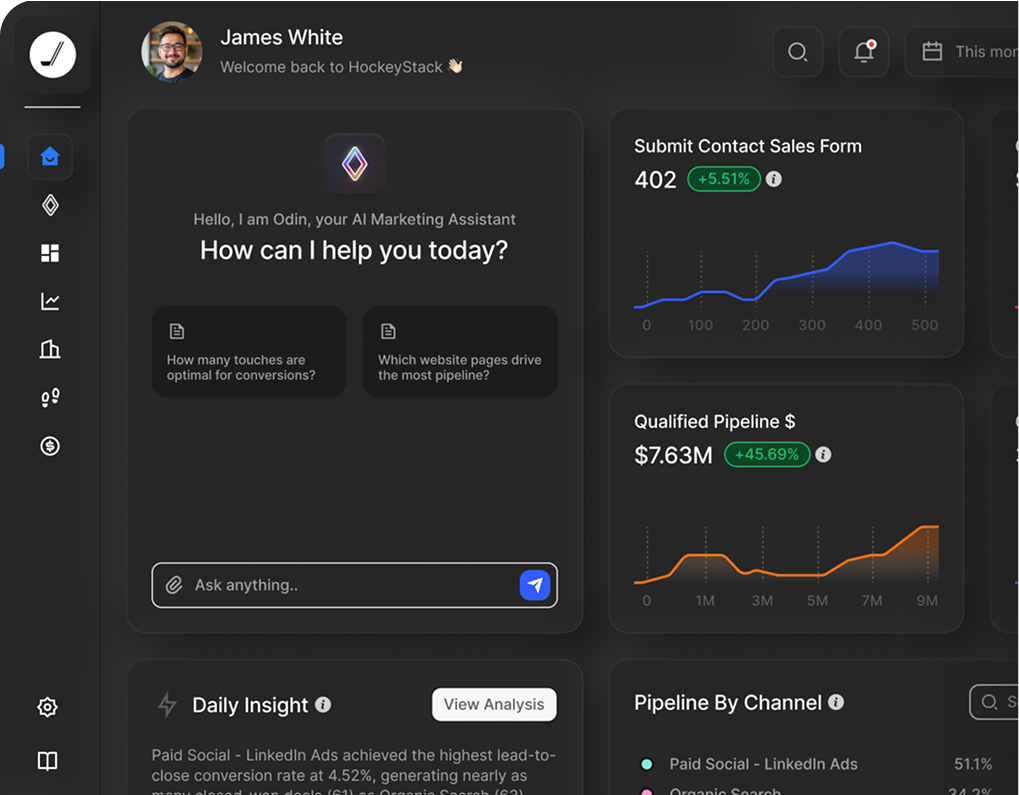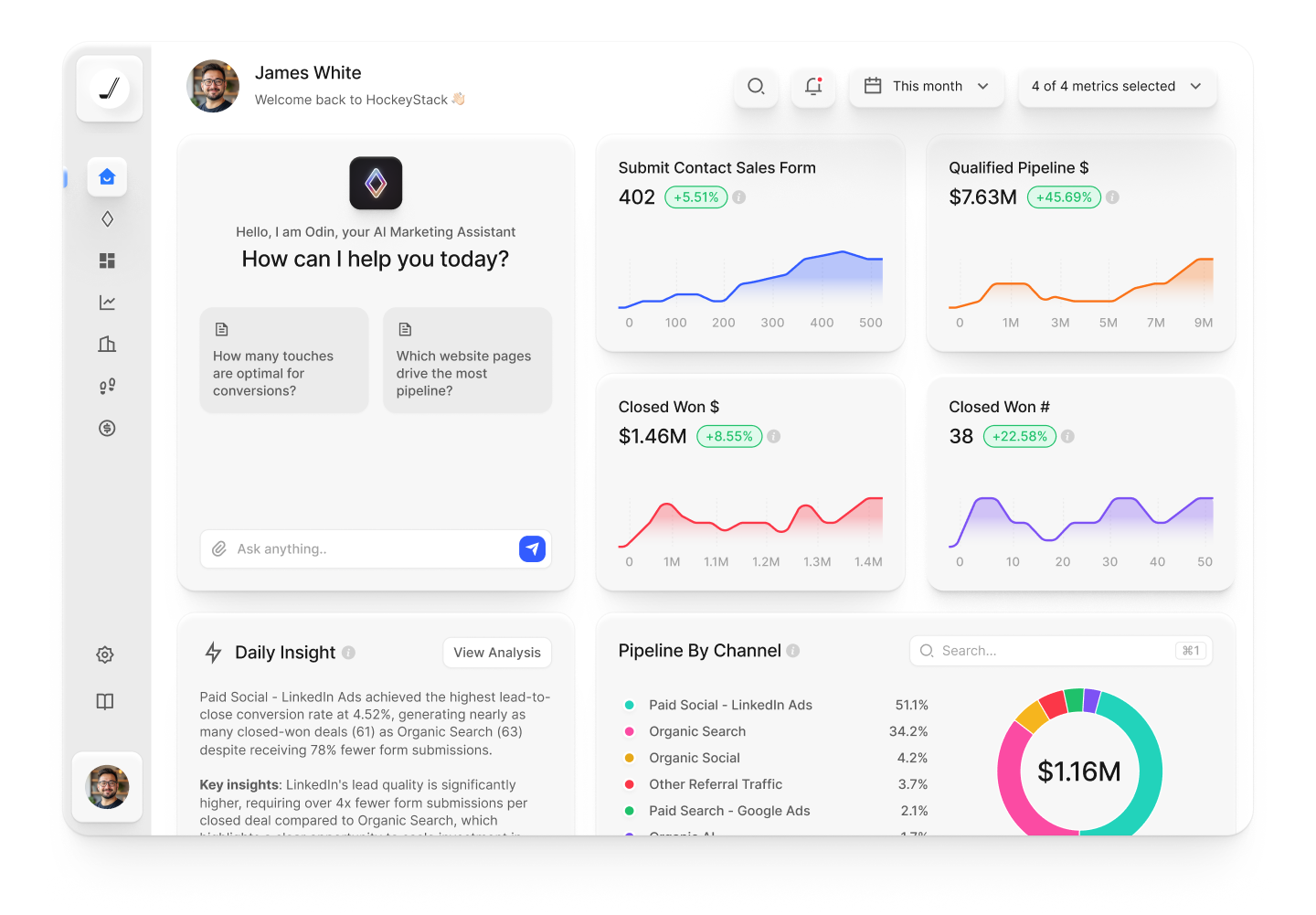Enterprise Attribution Excellence: Measuring and Proving Real Impact

Enterprise Attribution Excellence: Measuring and Proving Real Impact

Core Attribution Models for Complex Buyer Journeys
Different attribution models answer different strategic questions. First touch credits the initial touchpoint that brought someone into your ecosystem, making it valuable for measuring brand awareness and top-of-funnel campaigns. However, it ignores everything that happens after that initial interaction.
Last touch gives all credit to the final interaction before conversion. It’s helpful for understanding the final touchpoint that tipped the scales, but it undervalues all the nurturing that made conversion possible.
Linear attribution distributes credit equally across every touchpoint. This balanced approach prevents any single interaction from being over- or under-valued, though it treats a quick blog skim the same as a demo attendance.
Time decay gives progressively more credit to recent touchpoints, reflecting how recent interactions often influence decisions more. Yet this can undervalue early education that made later touchpoints effective.
U-shaped attribution emphasizes first touch and last touch equally while distributing some credit to middle touchpoints. This model recognizes that awareness and conversion are both critical, though it still treats the middle journey as less important.
W-shaped attribution credits three key moments equally: first touch, lead creation (typically a form fill), and opportunity creation (when sales accepts the lead). This aligns well with B2B funnels where these transitions represent meaningful changes in buyer intent.
Data-driven attribution uses machine learning to analyze thousands of journeys and assign credit based on which touchpoints actually correlate with conversion. This approach removes human bias and adapts as buyer behavior changes, though it requires significant data volume; typically thousands of conversions, to be accurate.
Steps To Build a Trusted Attribution Framework
Building enterprise attribution starts with mapping every system that touches customers. Audit your CRM, marketing automation platform, ad platforms, website analytics, sales engagement tools, and customer success software. For each system, identify who owns the data, how frequently it updates, and what customer identifiers it uses.
Identity resolution is the hardest technical challenge you'll face. You need to connect anonymous website visitors to known email addresses, link multiple contacts within the same company, and handle account hierarchies for organizations with subsidiaries. This requires sophisticated fingerprinting for anonymous users and business logic for rolling up activity to parent accounts.
Different systems describe the same activity in different ways. A LinkedIn ad click might appear as "paid social" in one tool and "LinkedIn Ads" in another. Consistent taxonomy for channels, campaigns, and content types ensures that when you measure paid social ROI, you're actually capturing all paid social activity.
Define clear stage definitions that match your sales process, decide which touchpoints count toward attribution, and set minimum engagement thresholds. For example, you might exclude internal traffic and filter out bot activity.
Regularly review attribution reports with sales and marketing teams to check whether insights align with their experience. When attribution credits a deal to a webinar but the sales rep says the executive sponsor never attended, investigate the discrepancy. These validation loops surface data quality issues and build trust in the system.
Causality Versus Correlation in Impact Analysis
Correlation tells you what happened together while causality tells you what actually caused results. This distinction matters because correlation alone leads to expensive mistakes.
Here's a common scenario: prospects who attend webinars convert at three times the rate of those who don't. The correlation is clear, but does the webinar cause higher conversion, or do late stage, highly engaged prospects simply choose to attend webinars? If you double webinar investment based on correlation alone, you might just spend more to reach people who would have converted anyway.
True causal analysis requires controlled experiments or statistical techniques that account for selection bias. Finance teams and executives increasingly demand this level of proof, especially for large budget decisions.
Validating Impact With Incrementality
We do not rely on traditional holdout tests that randomly exclude a portion of the target audience just to measure lift. Instead, we use an adaptive approach by comparing cohort and anti cohort performance, analyzing how engaged and unengaged groups behave over the same period to isolate true impact without withholding exposure. By comparing conversion rates between the two groups, you can measure true incremental impact. For example, if one group is exposed to a campaign and a comparable group is not, the difference in conversion rates represents the incremental lift, the results driven by the campaign itself.
Retrospective cohort analysis compares similar audiences who received different marketing treatments when randomized holdouts aren't feasible. You might compare accounts that entered your database in Q1 versus Q2, or prospects in regions where you ran different campaign strategies.
Geographic testing isolates impact by running different strategies in different regions. Test aggressive paid advertising in the Northeast while maintaining baseline spend in the Southeast, then compare pipeline generation rates. This works well for brand campaigns where individual-level randomization is difficult.
Metrics That Convince Finance and Leadership
CFOs and executives care about business outcomes, not marketing metrics. Pipeline created tracks new qualified opportunities generated by marketing touchpoints using multi-touch attribution. This connects marketing activity directly to sales pipeline, the leading indicator of future revenue.
Revenue influenced measures closed-won deals that involved marketing touchpoints during the buyer journey. This demonstrates marketing's contribution to actual bookings, though you'll lose credibility if you claim to influence 300% of revenue.
Cost per opportunity calculates total marketing investment divided by qualified opportunities created. This efficiency metric helps you compare channels and campaigns on equal footing. A channel might generate fewer opportunities but at much lower cost, making it more valuable than higher-volume alternatives.
Incremental lift quantifies additional pipeline or revenue generated above baseline performance using holdout experiments or time-series analysis. This proves causality rather than just correlation, making it the gold standard for justifying marketing spend. Even a 10-15% lift across your entire funnel represents significant additional revenue for enterprise organizations.
Payback period determines how long it takes for marketing investment to generate equivalent revenue return. Fast payback periods reduce financial risk and make it easier to secure budget for new initiatives.
Attribution only is a pitfall, best practice is to combine with lift
Single-touch models systematically miss the awareness and nurturing that made conversion possible, leading to underinvestment in top-of-funnel activities that actually drive demand. Sales calls, conferences, and direct mail influence enterprise decisions but often aren't captured in digital attribution models.
Duplicate CRM records, missing campaign tags, and inconsistent naming conventions corrupt attribution results and erode stakeholder trust. Attribution initiatives fail without cross-functional alignment on definitions, methodology, and how insights will drive decisions.
The solution to each pitfall is the same: invest in data governance, maintain open communication with stakeholders, and continuously validate that your attribution insights match reality.
Privacy Friendly Tracking and Governance
Cookie deprecation and privacy regulations change how attribution works, but they don't make it impossible. First-party data—information collected directly from your customers with their consent—becomes your primary attribution fuel. This includes form fills, email engagement, product usage, and authenticated website activity.
Server-side tracking and customer data platforms help you maintain attribution capabilities while respecting privacy. Instead of relying on third-party cookies, you use your own domain and infrastructure to track activity. This approach is more reliable, more privacy-compliant, and gives you complete control over your data.
Consent management platforms handle the complexity of different privacy regulations across regions and give users transparent control over their data. Building trust through ethical data practices actually improves attribution over time as more users consent to tracking.
Choosing the Right Enterprise Attribution Platform
The platform you choose determines whether attribution becomes a strategic asset or just another underused tool. Data coverage comes first; the platform should ingest data from every customer-facing system including CRM, marketing automation, ad platforms, website analytics, sales engagement, customer success, and product usage. Any gap in data coverage creates blind spots that distort attribution and insight.
Real time processing matters because it removes dependency, not just latency. Instead of waiting days or weeks for data teams, manual exports, or Jira requests, GTM and operations leaders can access attribution insights instantly and act on them the same day. When results appear within seconds, it is not about speed alone, it is about agility. It allows teams to route leads automatically, adjust campaigns in real time, and make confident decisions while opportunities are still active.
As attribution usage grows across your organization, data volume and query frequency increase dramatically. The platform's architecture scales efficiently without exponential cost increases. Ask vendors about their data processing technology and how pricing changes as you add users, data sources, and historical data.
Natural language querying and automated insights reduce dependency on technical teams and democratize access to attribution data. Marketing and sales teams ask questions and get answers without writing SQL or waiting for analyst support.
Enterprise attribution platforms should offer multiple attribution models so you can compare and contrast performance across different perspectives, and they should also be able to take action based on the insights they provide. Because these platforms handle sensitive customer data and business intelligence, verify that vendors maintain SOC 2 certification, support single sign on and role based access controls, and can meet your data residency requirements. Confirm their AI data usage policies as well, ensuring your attribution data is not used to train vendor models or shared with other customers.
From Attribution Insights to Action With HockeyStack
Attribution only creates value when it changes decisions. The most sophisticated model in the world is worthless if insights sit in dashboards instead of driving action.
HockeyStack's Odin AI turns attribution insights into recommendations. Instead of staring at dashboards wondering what to do next, marketing and revenue teams get specific guidance: "Increase investment in content syndication for mid-market accounts" or "Your enterprise deals stall at the security review stage—focus enablement there." This translation from data to action separates attribution systems that drive results from those that just produce reports.
Book a demo to see how HockeyStack's attribution platform handles your specific GTM complexity and data challenges.
Creating Demand on LinkedIn
LinkedIn is the bread and butter of B2B Marketing. In this video, Obaid shares his tips on how to create demand on LinkedIn.


Ready to See HockeyStack in Action?
HockeyStack turns all of your online and offline GTM data into visual buyer journeys and dashboards, AI-powered recommendations, and the industry’s best-performing account and lead scoring.




